
by Joshua Criss | May 22, 2025
Sweet potatoes (Ipomea batata) are a much ballyhooed southern food staple. Valued primarily for their tuberous roots, they also boast an edible leaf. That, however, is not the end of their story. Some cultivars find use strictly as an ornamental. While not the subject of this article, you will typically find these dangling over rock walls or cascading from a hanging basket. While these can be quite impressive, this article will focus on the edible version of this plant, and its nutritional benefits.
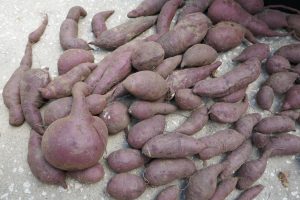
UF/IFAS photo: M. Bailey
What Cultivar?
As with any vegetable, these have been heavily bred to optimize growth and yield in our southern environment. In Florida’s Panhandle, ‘Centennial’ and ‘Beauregard’ are two varieties that perform admirably. They have a vining growth habit and are very productive. For those gardeners with less space, ‘Vardaman’ sweet potatoes. This cultivar has a bushy growth habit rather than a trailing vine.
Planting
Sweet potatoes are not planted by seed, but rather from a “slip”. These are the vegetative growth from the mature sweet potatoes. While it is possible to grow these yourself, it is better to utilize certified disease-free slips from a reputable garden supply store. Use slips that are 6 to 9 inches long, planting them in rows 48 to 54 inches on center, with plants spaced 12 inches apart.
Sweet potatoes can be planted in early spring through late June. These plants thrive in sandy soils, which are typical in the Panhandle with very little fertilization (approximately 0.04 lbs. of N on a 10 x 3-foot row). The downside to sweet potatoes is their exceptionally long growth season of 100 to 150 days after planting.
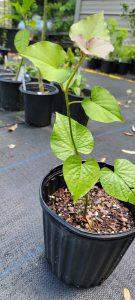
UF/IFAS photo: J. Criss
Pests
There are some pests which you’ll need to be wary when growing sweet potato. Most notably of these is the sweet potato weevil (Cylas formicarius). Even small amounts of damage from this insect can induce sweet potatoes with a foul taste. Control them through cultural practices such as turning your soil several months prior to planting, and adequate irrigation. Wireworms and beetle larvae are also concerns with sweet potatoes. Sample for grubs throughout the growing season, remove vegetation post harvest, and rotating your crops will keep these pests at bay. If all else fails, there are insecticidal options available. Consult your local extension agent to choose the appropriate option.

Sweet potato weevil UF/IFAS Photo: L. Buss
Time to Cure
Post harvest, sweet potatoes should be placed in a dark 85° room with 90% humidity for about two weeks. This is known as curing and will convert some of the starches of this vegetable to sugar making it slightly sweeter. Once the curing process is finished, store them in a cool, dry pantry at temperatures below 50°. This will keep them a viable staple in your pantry for several months.
The end result of all this work will be a food high in vitamin A, vitamin C and fiber that can be used for anything from home fries to pies.
To Sum Up
Growing your own vegetables in your own garden is a very rewarding experience. Sweet potatoes are an easy way to produce a lot of food for your family. If you’d like to know more about growing sweet potato, please consult these document. For more information on this topic or any other horticultural concern please contact your local U/IFAS extension office here.

by Joshua Criss | Mar 6, 2025
Ah, springtime is approaching quickly. You and I both know you’re getting anxious to get out into your gardens to grow your plants. I’m not faulting you, far from it. You’ll find that your local Extension agents want your garden to succeed as much as you do. Because we all want you to have a bountiful harvest, we need to have a conversation about fertility in your lawns and gardens.
Definitions
Before we get too deep into this topic, let’s define nutrition. You may hear some refer to fertilizers as “plant food.” While this is a common phrase concerning fertilizers, it is not factually accurate. Food is associated with energy creation within an organism. Plants are autotrophs, meaning they convert sunlight into energy. So, under this premise, sunlight is plant food, whereas plant nutrition is the building blocks of tissues or catalysts of metabolic processes.
The 17 elements designated as plant essential nutrients are categorized based on the quantity needed for healthy growth. All are important to have in your soil; as per the “Law of the Minimum,” your plant’s development will be limited based on the most deficient element.

UF/IFAS Photo
Macros
Those elements with the largest demand within the plant are known as macronutrients. The three most critical of these are very often absent in fertilizer conversations as they cannot be added to soil in granule form. These are carbon, hydrogen, and oxygen, and their presence in your garden results from your cultural practices. You get them from air and water in the pore spaces of your soil. Appropriate tillage and irrigation are the only ways to provide these elements to your plants. They are critical for proper photosynthesis and fluid balance in the plant.
The most discussed elements are so vital that they make up the three numbers on every bag of fertilizer. These are nitrogen (N), phosphorous (P), and potassium (K), all of which may be added to soil to overcome deficiencies (N often being the limiting factor). These elements are crucial for protein creation, photosynthesis, and fluid movement.
Secondary Nutrition
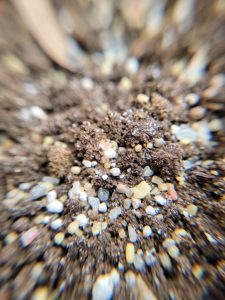
UF/IFAS Photo: J. Criss
The next set of nutrients have less demand than NPK. They are sulfur (S), magnesium (Mg), and calcium (Ca). Ca is essential for cell structure but is often abundant in our soils. S is frequently rained out of the atmosphere (though you may still need to add some) and facilitates enzymatic processes in plant cells. Mg needs the most attention in this category as it has a lot of mythology among gardeners. You’ve likely heard you should add this element to “green up” your plants. While it is true that Mg is critical to chlorophyll, adding it without testing for deficiencies first is a recipe for poor plant growth.
Micros
Our final category of fertilizer is micronutrients. These are iron (Fe), manganese (Mn), boron (B), chlorine (Cl), zinc (Z), copper (Cu), molybdenum (Mo), and nickel (Ni). These serve various functions in the plant, mainly in metabolic processes.
To Sum Up
Plant fertilization is critical for lawns and gardens. It behooves gardeners to understand these elements and their role in plant growth. Once you do, you’ll understand the importance of applying the correct version of the element in the proper amount at a time and location to maximize use efficiency. You can learn more about what they do and how they react in the soil here. For more information, contact your local extension office.

by Larry Williams | Feb 11, 2025
There are common reasons for failure with vegetable gardens in North Florida. One of those reasons is planting at the wrong time of year. We can grow vegetables year-round here in North Florida but it’s important to plant and grow the right vegetable during the right season. Most warm-season vegetables, such as tomato and cucumber, are planted and grow when frosts and freezes are not likely to happen. While the cool-season crops, such as strawberry and onion, are planted and grow during the cooler months of fall, winter and early spring. We have to be careful to select the correct varieties, as well.
Many gardeners overdo it in fertilizing and liming their gardens, which can result in failure. I’ve seen gardeners create problems in their gardens by watering too much or at the wrong time of day. Some gardeners use too much of a good thing such as mushroom compost, wood ashes, Epsom salt or copper fungicides in their gardens, creating lasting problems. And, unfortunately, too many gardeners don’t know how to identify beneficial insects versus pest insects and misuse insecticides as a result.
To be successful with vegetable gardening in North Florida, a person needs to know these basics. This is the kind of information I will cover in the free, two-hour seminar titled Home Vegetable Gardening 101.
The Home Vegetable Gardening 101 seminar is scheduled for Saturday, March 1, 10 a.m. to 12 noon at the UF/IFAS Extension Office in Crestview. The address is 3098 Airport Road in Crestview, FL. Please use the registration form below to register or call (850) 689-5850. Space is limited.
The registration form is here: https://forms.office.com/r/YTqt192MYB
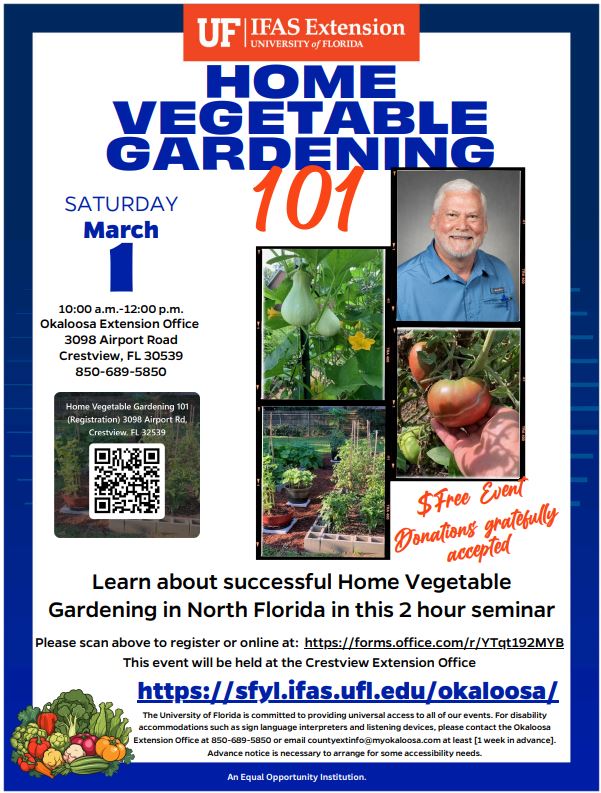

by Joshua Criss | Nov 21, 2024
A Sea of Yellow
You do not often see a sea of yellow flowers on what was recently a field of row crops in North Florida. In this instance, the culprit is a cover crop called sunn hemp (Crotalaria juncea). Cover cropping, or green manure as it is sometimes known, is not a new concept. It is a great method for improving soil quality, adding organic matter, augmenting nitrogen supply, supporting pollinators when resources begin to wane, and combating nematodes. Incorporating this sustainable agriculture practice into home vegetable gardens is an excellent method to build long-term viability and production.
Many plants may be used in this capacity, but this article will focus on sunn hemp. This annual is an herbaceous, short-day flowering plant in the Lamiaceae or legume family. Its erect stems produce a great deal of biomass and, as a legume, will augment nitrogen stores within your soil profile. As if that wasn’t enough to sell you, this plant is also known to suppress nematode populations. Native to India and Pakistan, where sunn hemp is grown for fiber, this plant grows well in tropical and temperate environments. It will thrive in even sub-par conditions and requires little fertilizer input.
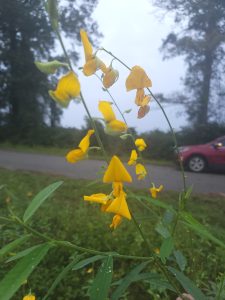
UF/IFAS Photo: Josh Criss
Seed Time
Seed this plant once your summer gardens have begun to wane. The shorter day length will keep the plant confined to about 3-4 feet while still allowing it to flower. It may also be planted earlier in the year to maximize below-ground biomass and add organic matter. In this scenario, the plant will likely grow to 7 feet tall with a closed canopy within 10 weeks.
Sunn hemp requires little fertilization as it is a legume, a plant family known to fix nitrogen from the atmosphere. This same mechanism is one of the features of this plant as a cover or green manure crop, as it can add up to 320 pounds of nitrogen per acre back to the soil when planted en masse.
Seeding rates within a home garden are much smaller. A farmer may plant 30-50 pounds of seed, which is not practical in small-scale growing. Instead, aim to cover the garden area through broadcasting seed, as a denser planting will reduce the later branching of this plant. Ensure you have 8-12 weeks of warm, frost-free weather, and terminate them prior to reaching the full bloom stage. Doing so will provide your gardens with the same benefits seen in farm fields utilizing this sustainable practice.
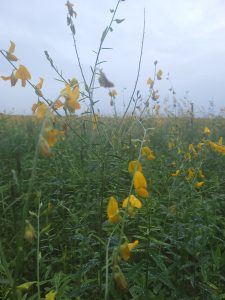
UF/IFAS Photo: Josh Criss
To Sum it Up
Sunn hemp is an excellent plant for your gardens before your fall greens. The biomass it produces and the nitrogen it recovers make it very attractive to farmers and should raise eyebrows even in the home garden. The trick is learning to manage this plant within your crop rotation. For more information on soil management refer to these IFAS documents, or contact your local extension agent for additional information on this and any topic regarding your gardens and more.
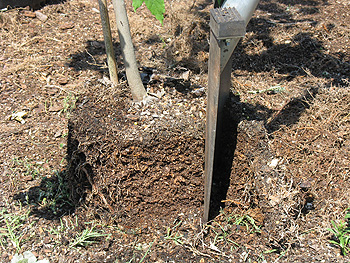
by Sheila Dunning | Nov 6, 2024
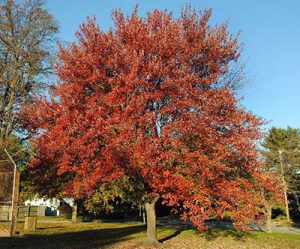
Red Maple structure IFAS Photo: Hassing, G.
Though the calendar says November, the weather in Northwest Florida is still producing summer or at least spring-like temperatures. The nice days are wonderful opportunities to accomplish many of those outside landscape chores. But, it is also a good time to start planning for next month’s colder temperatures. Since we don’t experience frozen soil, winter is the best time to transplant hardy trees and shrubs. Deciduous trees establish root systems more quickly while dormant; versus installing them in the spring with all their tender new leaves.

Remove an inch or more for extremely rootbound trees.
Here are a few suggestions for tasks that can be performed this month:
- Plant shade trees, fruit trees, and evergreen shrubs.
- Do major re-shaping of shade trees, if needed, during the winter dormancy.
- Check houseplants for insect pests such as scale, mealy bugs, fungus gnats, whitefly and spider mites.
- Continue to mulch leaves from the lawn. Shred excess leaves and add to planting beds or compost pile.
- Replenish finished compost and mulch in planting beds, preferably before the first freeze.
- Switch sprinkler systems to ‘Manual’ mode for the balance of winter.
- Water thoroughly before a hard freeze to reduce plants’ chances of damage.
- Water lawn and all other plants once every three weeks or so, if supplemental rainfall is less than one inch in a three week period.
- Fertilize pansies and other winter annuals as needed.
- Build protective coverings or moving devices for tender plants before the freeze warming.
- Be sure to clean, sharpen and repair all your garden and lawn tools. Now is also the best time to clean and have your power mower, edger and trimmer serviced.
- Be sure the mower blade is sharpened and balanced as well.
- Provide food and water to the area’s wintering birds.
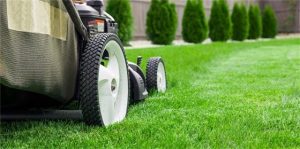
Mowing a lawn. Photo Credit: University of Florida/IFAS
















